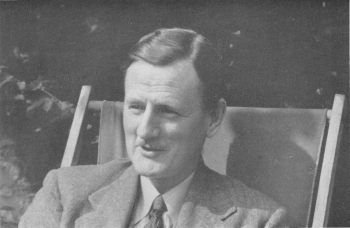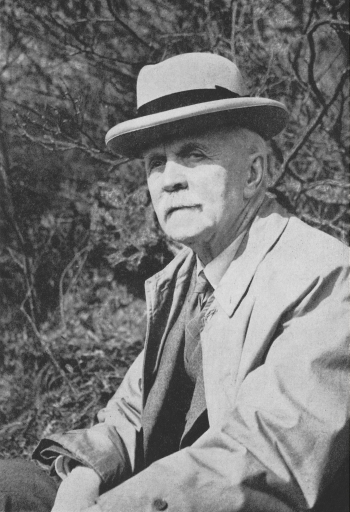IN MEMORIAM
Francis Sydney Smythe
It was one Sunday in December, 1919, soon alter Frankland, Somervell and I had crossed Pool Bridge on our way to climb at Almscliff, that a cyclist overtook us and introduced himself as F. S. Smythe, who had been proposed for the Club by Cuthbert Hastings. Smythe was a Berkhamstead boy and had been studying electrical engineering at Faraday House. He had come to Bradford for a year’s practical training.
Throughout that winter he climbed at Almscliff, and did his first Lakeland climb at Easter, 1920, up Pavey Ark Little Gully. I found him to be exceptionally strong, and after a fortnight with him in August I reported that he had climbed the Eagle’s Nest solo, and other severes, and that a new star had risen.
The next year he was back at Faraday House and had formed a friendship with J. H. B. Bell of the S.M.C. at Wasdalehead. Bell, thanks to a university friendship with a Russian mountaineering professor, has been the first Britisher to visit the Caucasus after the 1914/18 war.
In 1922 Frank went to Switzerland and Austria for further experience in hydro-electric work and in the two years that followed he wandered up and down the Eastern Alps and Dolomites building up a store of memories of delight. I joined him in August 1923 and together we did eleven Dolomite peaks, two really long and stiff. Great as Frank turned out later, I really believe he was most outstanding on the long Dolemite climbs, where route finding and great rock-climbing go hand in hand.
In 1925 after a further period of technical training in England, he was sent to Buenos Aires on telephone work, but life in the Argentine was so different from what he had expected that he broke his contract and joined the Royal Air Force. His squadron was sent to Egypt, where they were fed so badly that they all got poisoned, and in 1927 Frank was discharged as a permanent invalid. But he was a very hard nut and spent his gratuity re-establishing his health by Alpine climbing. He finished in superb form in September 1927 by leading Graham Brown up the Sentinel Route on Mont Blanc.
There is no need to detail his Himalayan progress from the Kanchenjunga expedition of 1930 – beginning with enthusiasm over German throughness and finishing with very definite views on international expeditions and the German attitude towards getting killed – through the Kamet success of 1931 to the great Everest expeditions of 1933, 1936 and 1938.
During the recent war Frank was first employed as an adviser on equipment and later in training troops, in Scotland and in the Rockies, to live and fight in the mountains. He finished by getting himself blown up on the Gothic line in Italy. The Rockies attracted him after the war, but he was on his way to the Himalayas in 1949 when he was taken ill and came home to die.
Laughter and joy fill my memories of Frank Smythe, he was an excellent correspondent – even from high camps on Everest – and all through he never lost touch with the Club. When we dined him in 1938, he reminded us that he had been half his life in the Y.R.C. He was a marvellous photographer and published many wonderfully illustrated books. Though many people think very highly of his Spirit of the Hills, I have always liked his Valley of Flowers best, myself.
E.E.R.
Thomas Gray
(President 1930-1931)
Tom Gray died in October 1950 aged 95. He was one of the first discoverers of Almscliff along with Edward Calvert, afterwards leader of the first English descent of Gaping Gill, when they were both students, and Gray was the second Englishman to stand on the floor of the great cavern.
He joined the Club in its second year and was on the Committee in its third. Our first Journal was brought out by Gray as editor in 1899. It may be mentioned that the Climbers’ Club was formed in 1898 and very soon published a quarterly journal. Gray edited eight numbers – 1899 to 1908. Slingsby, President for ten years from 1893, was extraordinarily well pleased with the Journals and their wide sweep. The letters between the two men show that their standard of criticism was very high.
During 1897 Gray made a short visit to the Alps and shared a new climb of importance with Calvert, but he seems to have been so deeply engaged in business and other affairs that he was never able to take long climbing holidays, though he was out in 1907 and 1911. He formed an amazing library of Alpine books and maintained a correspondence with Coolidge from 1896. Both were book collectors and had evidently much in common.
In the great pot-hole campaigns of 1897-99 I trace that Gray was down Sell Gill twice, Boggart’s Roaring Hole and was in some Rowten attacks. His removal to York interrupted them, but he continued to carry on correspondence with Martel and all the leading climbers of the day.
Throughout his long life he maintained a lively interest in the hills and in all activities connected with them, particularly those of the Club. At 88 he made a valiant attempt to climb Coniston Old Man and very nearly reached the top. He was most anxious to attend the 1949 meet at Sawley Hall in his 93rd year but was unable to do so. His friendship with mountaineers whose exploits are now legendary, his passion for accuracy and his amazing memory of events which took place 60 or 70 years ago, made a talk with Gray a fascinating experience for a younger man. He loved to talk with aspiring mountaineers and was always happy to draw upon his memories of past events to help the searcher for information.
His death severs one of the few remaining links with the early years of the Club.
H L S
Joseph Murison Davidson
(President 1936-1938)
The Wayfarers’ Dinner walk of December 4th 1949, was over Moel Fammau, and beyond it J. M. Davidson passed peacefully away among his friends. A great climber and a great leader, he had been a member of the Wayfarers since 1907, of the Y.R.C. since 1910, and President of both.
For a brief time in 1908 I was the last-joined member of the Alpine Club and the Y.R.C., and through Fred Botterill joined Davidson and his great friend Dr. E. A. Baker in the Alps. Davidson had climbed at Kandersteg with the Ogis and had four seasons. In much snow the Ogis took us over the Alphubeljoch, up Rimpfischorn from the Adler, across the Rothorn and back over the Gabelhorn, then we did the High Level to Mauvoisin, and from Champex over the Col de Chardonnet guideless.
Davidson had a short holiday in 1909 when with Oppen-heimer and Fox we crossed Mont Blanc and climbed the Aiguille du Geant, the escape from death by lightning of which he wrote. Of the Charmoz rocks we learnt a great deal. By this time I realised that he was not only strong, as daring as he was cautious, but a versatile athlete.
1910 was a great season in Dauphine. With Lamb and young Crawford we made three first ascents of the season, Pelvoux, Rateau with Crawford, next day the superb traverse of La Meije with Lamb. Davidson led up the Great Wall, came last down to Breche Zsigmondy without using the pitons and led up from it. We were all in great form and pushed on relentlessly. The ice slope was cleared at 5 p.m. and we were in La Grave about eight. The traverse was done two days after and not again in 1910. We did also the Aiguilles d’Arves but had no chance with the Ecrins.
In 1911 with Lamb he did Mont Pourri and others, learning that a dirty shed can be preferable to a freezing bivouac. From the Col du Geant he traversed the Rochefort Ridge to Mount Mallet with Hazard and me, and in the next week we traversed the Charmoz and the Grepon and did the Grand Dru.
In 1912 Davidson and Hazard began with the Todi and arrived at Rosenlaui and the Engelhorner, where the next season we did many limestone peaks and he met Mdlle. Genevieve Oltramare. Three years later they were married.
In 1914, in the Bregaglia he did little beyond the Zocca. The war called us home, but the Ago di Sciora had a narrow escape. Our plans for the Brenva and the Peteret were smashed for good; the ordinary incidence of leave and engagements never allowed us to climb in the Alps together again. After the First War he was sent to establish the English Bank at Cologne, returning in 1923, and later on he was sent to Milan for some years on a similar mission, repons-ibilities for which his command of French, German and later Italian singled him out.
Davidson climbed a great deal with Ling and Unna after the war and while at Milan did some severe Monte Rosa climbs with guides. He was at one time on the Alpine Club Committee.
Tom Booth drew him into the Y.R.C. and pot-holing in 1910. He was in the excursion in 1923 which revealed the big pitches of Juniper Gulf, and in the very slick descent in 1938. I remember too our descent of G.G. Flood Entrance with a strong novice in 1936 when both over sixty, the final day in Lost John’s, far along the Master Cave in 1937, and the completed exploration of Pollnagollum of the Boats in 1939.
During the last War, though long retired, he and Mrs, Davidson stood sternly by battered Merseyside. A man of great social charm, he died among a host of friends and among the hills he loved.
E.E.R.
F. H. Mayo
It is with deep regret that we announce the death, early in 1951, of one of our oldest members, Dr. F. H. Mayo.
Dr. Mayo joined the Club in 1897. At the time of the publication of our first Journal in 1899 he was a member of the committee, and he was a Vice-President in 1901. His initials appear under a number of Reviews in the earlier journals, mainly those dealing with medical subjects and rescue.

